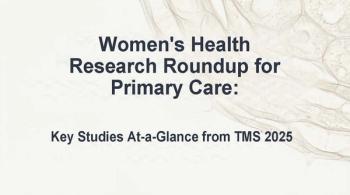
Episternal Ossicle
An 87-year-old woman was referred for a newly discovered neck mass. She denied any history of neck mass, dysphagia, odynophagia, stridor, shortness of breath, or globus sensation. She had experienced no change in voice.
An 87-year-old woman was referred for a newly discovered neck mass. She denied any history of neck mass, dysphagia, odynophagia, stridor, shortness of breath, or globus sensation. She had experienced no change in voice.
The patient was thin, alert, and oriented. The ears, nose, and throat were normal, with the exception of a 2- × 2-cm, firm, midline mass located in and immediately below the thyroid gland at the level of the clavicles. The lesion, which did not elevate with tongue protrusion, was nontender and fairly immobile. No associated lymphadenopathy was noted.
Needle aspiration for a tissue evaluation was attempted. The 21-gauge needle was unable to penetrate the mass. A very recent chest film had disclosed no abnormality. A high-resolution CT scan of the neck was obtained (Figure); an episternal ossicle was depicted (arrow).
Drs Paul E. Lomeo, David R. Rabaja, Michael A. Schmidt, and John E. McDonald of Muskegon, Mich, write that episternal ossicles are a normal variant of the sternum. First described by Cobb in 1937,1 episternal ossicles have received scant recognition. The development of increasingly accurate imaging technologies has led to more frequent identification of these anatomic structures.2
When growth is normal, the dagger-shaped sternum is divided into three sections: the manubrium, or upper handle; the body, or mid blade; and the xiphoid process, which is the lower, cartilaginous segment. The xiphoid-the smallest portion of the sternum-ossifies during adulthood. The manubrium articulates with the clavicle and the first rib; the next nine ribs join the body of the sternum directly or indirectly. The body is a flat, cancellous bone that measures 16 to 20 cm in adults.
Episternal ossicles usually occur superior or posterior to the manubrium and between the clavicles.
Episternal ossicles are also known as ossa suprasternalia, substernal ossicles, and accessory sesamoids of the sternum. They originate by the sixth month of gestation as supernumerary ossification sites from median sternal mesoderm. Episternal ossicles are initially cartilaginous; they generally ossify between the ages of 17 and 23 years but have been noted to ossify as early as age 12 years.
Ossicles are more often unilateral than bilateral; when unilateral, they occur twice as commonly on the left. They may be fused to the manubrium or sternoclavicular joint disc.3 Some have a joint capsule that can be either separate from or continuous with the manubrium.
The overall incidence of episternal ossicles ranges from 1.5% to 2.5% in the general population.1,4 They are more common in white than in black persons.4 There is no gender predilection.
Here, a single or fused pair of ossicles is seen in the midline of the neck, with the clavicle visible laterally. The ossicles show central hypointensity, suggestive of cortex or medullary bone. This ossicle was 17 mm in diameter, which is larger than the average of 10.5 mm.1 Before modern imaging techniques, these ossicles were not noticed until advanced age and neck muscle atrophy made the masses palpable.
It is important to recognize episternal ossicles as a normal variant of sternal development. On physical examination, they may be mistaken for lymph nodes, thyroid nodules, thyroid goiters, or vascular calcification. Usually, a chest film is negative. However, on a CT scan of the neck and sternum, episternal ossicles are obvious. The CT scan is the diagnostic procedure of choice.2,5,6,7
This patient continues to have no symptoms. No treatment is needed or recommended for sternal ossicles.
REFERENCES:1. Cobb. J Anat. 1937.
2. Stark P, Watkins GE, Hildebrandt-Stark HE, Dunbar RD. Episternal ossicles. Radiology. 1987;165:143-144.
3. Elster AD, Stark P. Episternal ossicles: a normal CT variant. ROFO. 1985;143:246-247.
4. Stark P, Jaramillo D. CT of the sternum. AJR. 1986;147:72-77.
5. Moore MK, Stewart JH, McCormick WF. Anomalies of the human chest plate area. Radiographic findings in a large autopsy population. Am J Forensic Med Pathol. 1988;9:348-354.
6. Goodman LR, Teplick SK, Kay H. Computer tomography of the normal sternum. AJR. 1983;141:219-223.
7. Stark, P. Computer tomography of the sternum. Crit Rev Diagn Imaging. 1987;21:321-349.
Newsletter
Enhance your clinical practice with the Patient Care newsletter, offering the latest evidence-based guidelines, diagnostic insights, and treatment strategies for primary care physicians.


















































































































































































































































































